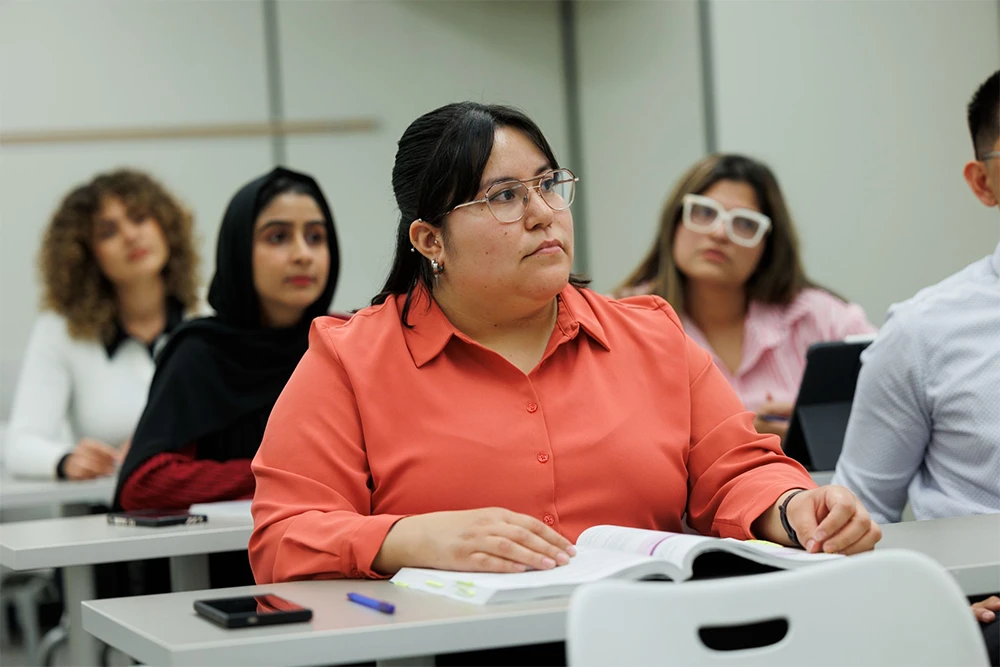Table of Contents
On September 30, you’ll see orange shirts across schools, workplaces, and city streets. Behind every shirt is the story of Phyllis Webstad, whose new orange shirt was taken away on her first day at a residential school.
Between 1867 and 1996, residential schools across Canada were part of a system that separated thousands of First Nations, Métis, and Inuit children from their families. While experiences varied, many children faced harsh conditions, loss of language and culture, and mistreatment that caused lasting harm to individuals and communities. When Phyllis shared that memory, it became the spark for Orange Shirt Day, a movement that now reminds us of the children who never returned home and the survivors who continue to share their truths.
Since 2021, the date has also been recognized as the National Day for Truth and Reconciliation (NDTR), a time to reflect on the impact of residential schools and to learn more about the Indigenous history of Canada while asking ourselves how we can contribute to reconciliation in everyday life.
Listen to: Orange Shirt Day & National Day for Truth and Reconciliation: How to Honour & Learn
Understanding Orange Shirt Day & Truth and Reconciliation
Truth and Reconciliation is not only a matter of history, it is a responsibility carried forward. To guide this work, the Truth and Reconciliation Commission of Canada was established in 2008 as part of the Indian Residential Schools Settlement Agreement. The Commission gathered thousands of survivor testimonies, creating a national record of the harm caused by the residential school system and its lasting effects on Indigenous families and communities.
In 2015, the Commission released its final report, which included 94 Calls to Action. These recommendations continue to serve as a roadmap for governments, schools, organizations, and individuals. They call for changes in education, health, justice, child welfare, and cultural revitalization. The Calls to Action connect directly to the meaning of Orange Shirt Day, reminding us that reconciliation grows stronger when we commit to both learning and action in our daily lives.
Personal Ways to Honour National Truth and Reconciliation Day
Honouring the National Day of Truth and Reconciliation begins with listening. Reading or watching survivor testimonies through the National Centre for Truth and Reconciliation reveals the impact of residential schools and the strength it takes to speak these truths. Every story pulls you closer to the reality Indigenous families lived and the lasting effects they continue to carry today.
The truths of residential schools live not only in survivor stories but also in the history of this country. One way to learn more is by exploring the treaties that apply to the region where you live. Treaties are part of Canada’s foundation and continue to shape relationships today.
Resources such as Native-Land.ca provide maps showing territories, languages, and treaties. You can enter your address to learn more about your area or use the search function to see how Indigenous languages are spoken across regions.
Even small steps – like sharing what you’ve learned in conversation at work or introducing these lessons to children – help build broader awareness of Indigenous cultures and histories.
Wearing an orange shirt carries that awareness into public spaces. Each shirt honours the children who never came home and the survivors who continue to share their truths. When these shirts are purchased through Indigenous-led initiatives, it honours survivors while supporting communities directly. The shirt stands as a visible reminder that reconciliation lives through both learning and action.
Community Involvement
Many communities host ceremonies, walks, and educational gatherings in recognition of this day. Community members take this opportunity to honour the lost, show support for survivors, and build mutual understanding.
In 2025, the national gathering Remembering the Children will once again take place on Parliament Hill, with broadcast coverage to reach people across the country. In Saskatchewan, events such as the Pow Wow – Every Child Matters and the Rock Your Roots Walk for Reconciliation, people come together in reflection and solidarity.
Participating in Indigenous culture events like this connects you with the ongoing efforts of reconciliation.
Reconciliation Education
Education is one of the most powerful ways to advance reconciliation. When you read a book, join a class, or listen to a survivor’s story, you’re taking part in learning that shifts perspectives. The National Centre for Truth and Reconciliation offers various resources such as teaching guides, presentations, a memorial book, and other publications, and it hosts an annual Truth and Reconciliation Week, giving students and teachers space to learn and reflect together.
In addition to school settings, free courses and community programs in many regions invite people of all ages to explore Indigenous histories and contemporary realities. These Indigenous educational resources are open to everyone who wants to deepen their knowledge and take part in reconciliation education.
Indigenous Education Resources
Stories are often the best way to learn about indigenous history. Listening to Phyllis Webstad through the Orange Shirt Society brings the meaning of Orange Shirt Day into focus. The National Centre for Truth and Reconciliation shares survivor stories and archival records so these voices remain accessible for future generations.
In addition to the 94 Calls to Action, the Truth and Reconciliation Commission has published an extensive history of Canada’s residential schools, information about missing children and unmarked burials, and details regarding the Metis, Inuit, and Northern experiences.
Engaging with Indigenous education resources like survivor testimonies, archival records, and detailed histories shows how reconciliation continues through actions that individuals, communities, and institutions can support.
NDTR Provincial Resources
Reconciliation efforts take different forms across provinces, influenced by local history and community leadership. Learning about what’s happening in your region helps you take part in Indigenous education initiatives that honour survivors and improve relationships with Indigenous communities.
NDTR in Saskatchewan
The Office of the Treaty Commissioner provides classroom resources and public programs that keep treaty education active throughout the province. Community events such as Rock Your Roots in Saskatoon bring thousands together in honour of survivors and to celebrate Indigenous cultures. Museums and heritage sites, including Wanuskewin, host Indigenous awareness events that tie history to living traditions.
NDTR in Manitoba
With the National Centre for Truth and Reconciliation (NCTR) based in Winnipeg, the province is home to many Indigenous-led initiatives. Each year, the NCTR leads Truth and Reconciliation Week, bringing together schools and communities with events rooted in Winnipeg. One example is the Centre’s Youth Empowerment Gathering, and in 2025 its theme “The Gifts We Carry” highlights the role of young people in reconciliation. Community events such as the Healing Walk at The Forks give families and survivors space to share stories and healing practices. The Manitoba Museum hosts exhibits that connect residential school history to broader conversations about reconciliation.
NDTR in British Columbia
The First Nations Education Steering Committee (FNESC) develops curriculum and teacher resources that embed Indigenous perspectives in classrooms. The Royal BC Museum, along with Indigenous cultural centres such as U’mista in Alert Bay, provides tours and exhibits led by Knowledge Keepers. Community events, like the Victoria Orange Shirt Day Ceremony, bring together schools, families, and local leaders each year.
Digital and Online Resources
For those who cannot attend in person, online platforms extend the reach of reconciliation. The National Centre for Truth and Reconciliation’s digital archives preserve survivor stories, photographs, and government records. The Aboriginal Peoples Television Network (APTN) and the Canadian Broadcasting Corporation (CBC) share national coverage of Orange Shirt Day events. Free online courses such as Indigenous Canada or language revitalization programs make learning accessible from anywhere. These Indigenous digital tools allow you to stay engaged no matter where you live.
Year-Round Indigenous Cultural Awareness
Reconciliation does not begin and end on September 30. It continues in the choices we make each day. Supporting Indigenous-owned businesses, attending or volunteering at powwows and cultural festivals, or learning a few words in a local Indigenous language are simple ways to stay engaged with Indigenous voices and communities. Returning to the Calls to Action throughout the year reminds us that reconciliation grows through ongoing effort.
By carrying these practices into daily life, the spirit of Orange Shirt Day continues long after the day itself.
SBC College’s Commitment to Indigenous Education & Reconciliation
At SBC College, we recognize the importance of the National Day for Truth and Reconciliation and Orange Shirt Day. These days are not only moments of remembrance but also reminders of our shared responsibility to honour Indigenous communities with respect and care.
Supporting Indigenous voices is a year-round responsibility. Through education, community involvement, and advocacy, we strive to contribute to reconciliation and to make sure that every learner feels valued and supported.
FAQs
Are there online reconciliation education programs I can take year-round?
Yes. Free digital resources from the National Centre for Truth and Reconciliation, language revitalization programs, and archives of survivor stories are available anytime.
What is the history behind Orange Shirt Day in Canada?
Orange Shirt Day began with Phyllis Webstad’s story of having her new orange shirt taken away on her first day at a residential school. It grew into a National Day of Remembrance that honours survivors and children who never returned home.
How can I access reconciliation education resources?
Resources are available through the National Centre for Truth and Reconciliation, the Orange Shirt Society, Native-Land.ca, and provincial education offices.
What can schools and workplaces do to honour September 30?
Schools can incorporate lessons, share survivor stories, and organize discussions. Workplaces may host learning sessions, invite Indigenous speakers, and encourage staff to wear orange while reflecting on the meaning of the day.
How can Canadians support Indigenous communities year-round?
Supporting Indigenous businesses, attending cultural events, volunteering with community organizations, and revisiting the Calls to Action are practical ways to stay engaged beyond September 30.






